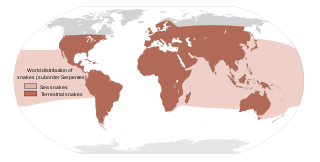Horned viper may refer to:
- Cerastes (genus) , North African desert vipers, a group of small, venomous species found in the deserts and semi-deserts of northern North Africa eastward through Arabia and Iran
- Bitis caudalis , the horned puff adder, a venomous species found in the arid region of south-west Africa
- Vipera ammodytes , the sand viper, a venomous species found in southern Europe through to the Balkans and parts of the Middle East
- Viper (hieroglyph)

Cerastes is a genus of small, venomous vipers found in the deserts and semi-deserts of northern North Africa eastward through Arabia and Iran. Three species are currently recognized by "ITIS", and an additional recently described species is recognized by the Reptile Database. Common names for members the genus include horned vipers, North African desert vipers, and cerastes vipers.
Bitis caudalis is a venomous viper species found in the arid region of southwest Africa, easily distinguished by the presence of a single, large horn-like scale over each eye. No subspecies are currently recognized.

Vipera ammodytes is a viper species found in southern Europe through to the Balkans and parts of the Middle East. It is reputed to be the most dangerous of the European vipers due to its large size, long fangs and high venom toxicity. The specific name, ammodytes, is derived from the Greek words ammos, meaning "sand", and dutes, meaning "burrower" or "diver", despite its preference for rocky habitats. Five subspecies are currently recognized, including the nominate subspecies described here.
| This article includes a list of related items that share the same name (or similar names). If an internal link incorrectly led you here, you may wish to change the link to point directly to the intended article. |






